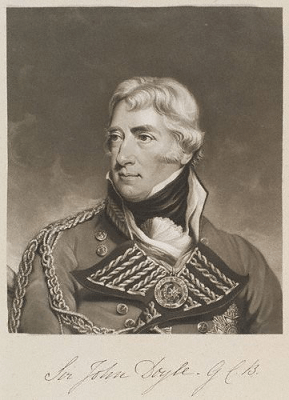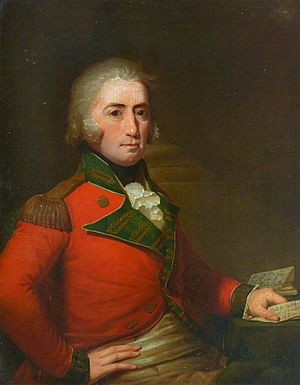Sir John Doyle, 1st Baronet facts for kids
Quick facts for kids
General Sir John Doyle, Bt
|
|
|---|---|
 |
|
| Born | 1756 Dublin, Kingdom of Ireland |
| Died | 8 August 1834 (aged 77–78) |
| Allegiance | United Kingdom of Great Britain and Ireland |
| Service/ |
Army |
| Years of service | 1771–1820s |
| Rank | General |
| Battles/wars | American Revolutionary War – Brooklyn, Harlem Heights, Springfield, Brandywine, Germantown (wounded), Monmouth Courthouse, Siege of Charleston French Revolutionary Wars – Holland (wounded), Gibraltar and Egypt |
Sir John Doyle (1756 – 8 August 1834) was a brave Irish officer in the British Army. He joined the army in 1771 and served with great skill. He fought in two major wars: the American War of Independence and the French Revolutionary Wars.
John Doyle also became a politician. He was elected to the Irish Parliament in 1783. Later, he served as the Secretary of War for Ireland. King George III thought highly of his efforts. The King wanted everyone to remember Doyle's hard work and dedication.
Later in his career, Doyle became a special assistant to Prince George. He was also made Lieutenant Governor of Guernsey from 1803 to 1813. He worked to improve the island's defenses. In 1813, he was knighted, and in 1819, he became a General. He was made a Baronet in 1825, but this title ended when he passed away.
Contents
Early Life and Family
John Doyle was born in Dublin, Ireland, in 1756. He was the fourth son of Charles and Elizabeth Doyle. He started studying law at Trinity College Dublin in 1768. However, his father died in 1771, and John decided to join the army instead.
John Doyle was the uncle of Anna Wheeler, who fought for women's political rights. In 1812, Anna and her daughters stayed with John and his family in Guernsey.
Military Adventures
Doyle began his army career in March 1771. He joined the 48th (Northamptonshire) Regiment of Foot as an ensign, which is a junior officer rank. He quickly earned promotions, becoming a Lieutenant in 1773.
Fighting in America
Doyle moved to the 40th (2nd Somersetshire) Regiment of Foot when it was sent overseas. He fought bravely in the American War of Independence (1775–1783). He was a lieutenant in the light cavalry at Boston. He became an adjutant, helping his commanding officer.
In August 1776, he took part in the Battle of Long Island. During this battle, he bravely rescued the body of his commanding officer, Lieutenant-Colonel James Grant, while under enemy fire. He also fought in the Battle of Harlem Heights. In 1777, he was at the Battle of Brandywine and the Battle of Germantown, where he was wounded.
Because of his injury, Doyle was asked to help raise a new regiment called the Volunteers of Ireland. He was promoted to captain in this unit. This regiment fought at the Battle of Monmouth Courthouse in 1778. Doyle then became a Major of Brigade and moved with his regiment to South Carolina. He helped in the Siege of Charleston in 1780. He was also praised for his actions at the Battle of Camden and the Battle of Springfield.
After the war ended in America in 1782, Captain Doyle returned to Ireland and entered politics.
Wars with France

When France declared war on Great Britain in 1793, Doyle created his own regiment. It was called the 87th (The Prince of Wales's Irish) Regiment. They were also known as The Prince of Wales Irish Heroes.
Doyle was promoted to colonel. He led his unit in the Flanders Campaign from 1793 to 1795. He fought at the siege of Valenciennes in 1793. He also showed great courage at Alost in 1794, where he was wounded in a cavalry fight. He had to return to Britain to recover. While he was away, his regiment was sent to Bergen op Zoom. The town surrendered to the French, and his entire regiment became prisoners of war.
After recovering, he returned to Ireland and became head of the war department. He served as Secretary of War from 1796 to 1799. His regiment was released, and Doyle was made Colonel of the 87th Foot in 1796.
He was promoted to Brigadier-General. In 1796, he was put in charge of land forces for a planned attack on the Texel to destroy the Dutch fleet. However, bad storms stopped the attack. Brigadier General Doyle was then ordered to Gibraltar. On his way, he was attacked by robbers and badly wounded. After he recovered, he joined the staff in Gibraltar.
Doyle was confirmed as a Brigadier General and led the 4th brigade. He served in Egypt in 1801 under Generals Abercromby and Hutchinson. He saw action at Manresa, Marabout, and Ramanieh. In May 1801, in the Egyptian desert, he led 250 soldiers to capture 600 French soldiers without a fight. This was a great achievement. He helped with the surrender of Cairo and the Alexandria in September. His excellent leadership led to his promotion to Major-General in 1802.
Defending Guernsey
In 1803, Doyle was appointed Lieutenant Governor of Guernsey. In 1804, he declared a "state of emergency" because of the threat of invasion from France. He worked hard to improve the island's defenses. He built over 60 new gun batteries at likely landing spots. He convinced the islanders to pay for these defenses, explaining the danger they faced.
Doyle actively organized Guernsey's defense. He oversaw the draining of land at Braye du Valle. This connected the northern part of the island to the main island. He used the money from selling this land to build military roads. He also had three Martello towers built, including Fort Grey, to add to the existing towers. He also completed Fort George. He worked closely with the Royal Guernsey Militia and brought more supplies and soldiers to the island. He also improved the defenses of Alderney.
Public Service and Recognition
After the American War of Independence, Doyle returned to Ireland. He became a founding member of the Irish Whig Club. He was an early supporter of Catholic emancipation, which meant giving Catholics more rights.
In 1783, he became a MP for Mullingar in the Irish House of Commons. He gave speeches in the Parliament of Ireland to help starving Irish workers and their families. For this, he was given the freedom of Dublin city. He also spoke up for disabled soldiers and abandoned children.
His work caught the attention of the Prince of Wales, who appointed Doyle as his Private Secretary. He also served as Secretary of War in Irish politics from 1796 to 1799.
Doyle was praised by the people and government of Guernsey and Alderney. He was made a Baronet in 1805. He was promoted to Lieutenant-General in 1808 and became a Knight of the Bath in 1812. In 1819, he was promoted to a full General. From 1818 until his death, he was Governor of Charlemont Castle.
Legacy and Commemoration
King George III wrote about Doyle, saying his hard work and dedication should be remembered forever.
Doyle was also a high-ranking member of the Freemasons. In 1806, he received the 'Doyle Cup'. This cup is now in the Museum of Freemasonry in London. It shows Doyle's Freemasonry and his military career in the French Revolutionary Wars. Another Masonic cup, showing scenes from the American War of Independence, is still in Guernsey.
Guernsey has honored Doyle in many ways. There is the Doyle Monument at Jerbourg Point. Several places are named after him, including Doyle Road, Fort Doyle, Doyle Street, Doyle Lane, Doyle Close, and The Doyle (which was once the site of Doyle Barracks).
See also
- John Milley Doyle

